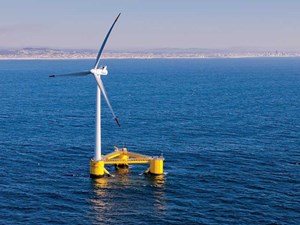OTC 2022: Department of Energy to boost investment in U.S. offshore wind development
HOUSTON (WO) — The offshore wind sector has made huge strides over the last year, putting the industry on track to achieve President Joe Biden’s goal of reaching 30 gigawatts of offshore wind generation by 2030. To ensure its success, the U.S. Department of Energy (DOE) is allocating funds and programs to the development of projects in the Gulf of Mexico, Central Atlantic and off the Oregon coast.
Jocelyn Braun-Saracino, the offshore wind lead for the DOE, outlined the department’s strategy to advance offshore wind development during the OTC session “Shaping the Future: Offshore Wind Growth in the United States” on Thursday.
“Achieving this goal will be critical in creating a new industry, revitalizing the nation's water fronts, creating good-paying jobs and critically helping address the nation's climate emergency … from an economic perspective, meeting that goal could also spur $12 billion in capital investments and projects annually between now and 2030,” Braun-Saracino said.
The Biden administration has called for the Wind Energy program, which historically had a budget of $60 million per year, to increase 86% next year to total $200 million. The budget will go toward selecting sites for turbines, developing cost-effective floating platform designs, and coupling offshore wind energy to energy storage and hydrogen production.
In addition, the Title XVII Program ran by the DOE’s Loan Programs Office has earmarked $4.5 billion in loans and loan guarantees for offshore wind projects, she said.
“We're really working to support R&D that improves the performance of offshore wind turbines and plants,” she said. “We want to make sure we have a robust understanding of the offshore wind resource, we're enabling economies of scale, and that we're creating a path forward for the adoption of floating offshore wind in United States.”
In April, the Department of the Interior announced that the Bureau of Ocean Energy Management (BOEM) identified two potential areas for offshore wind development off the coast of Oregon and in the Central Atlantic. The locations total 1.16 million acres and are about 12 nautical miles from the shore in central and southern Oregon.
The agency also identified six areas totaling 3.9 million acres between Delaware and North Carolina as potential sites for wind turbine. The areas are about 20 nautical miles or more from shore.
These projects are expected to create 77,000 new jobs — 44,000 in offshore wind and 33,000 in the surrounding communities.
According to Braun-Saracino, these projects will not only help the U.S. achieve 30 gigawatts of wind generation by 2030, but also puts it on track to hit its larger goal of 110 gigawatts from offshore wind projects by 2050.
“I think these goals are powerful,” Braun-Saracino said. “They help foster the sort of investment environment that we need for companies to make supply chain investments. And I think, importantly, they also provide a groundwork for planning. They help us determine what do we need to be planning for, what are the issues that we need to be planning around.”
Still, to reach the 2030 and 2050 goals requires the deployment of 2,100 wind turbines, 6,800 miles of cable, five to six wind turbine installation vessels, 10 transport vessels, 11 service operation vessels and 58 crew transfer vessels.
The U.S. only runs seven offshore wind turbines presently — all fixed bottom turbines.



